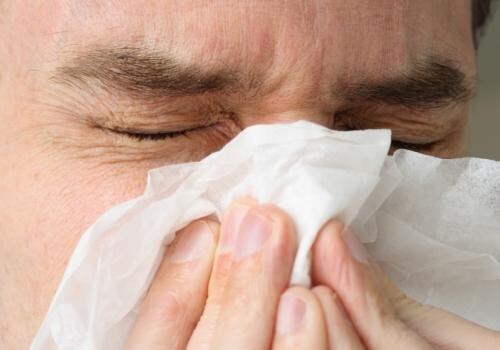-

What is allergy?
Allergy is a condition characterised by a level of sensitivity greater than normal to a specific substance or group of substances. These substances, called allergens, trigger a response in susceptible individuals. They can enter the body through various routes like inhalation, ingestion, injection, and external skin contact. They react with antibodies in a susceptible person, causing the release of histamine (a chemical mediator in allergic reactions) and other chemical substances that cause various symptoms. This creates a chain response known as the allergic response.
-

What is the cause?
Allergic reactions may be caused by many factors. These include the most common allergy 'triggers' like pollen grains, dust, moulds and foodstuffs. Other triggers include animal proteins from hair, and fur and substances that cause skin allergic reactions such as certain oils found in plants, drugs, cosmetics, chemicals etc. The allergies can be classified as seasonal allergies and perennial allergies.
- Seasonal allergies
Seasonal allergies occur during certain seasons of the year. They are caused by inhaling microscopic particles in the air and substances like pollen released by plants, grasses and weeds. This can lead to a sustained allergic response.
- Perennial allergies
Perennial allergies occur throughout the year. They occur due to mould, fungi and dust found indoors. Perennial allergies can be caused by fur from cats and dogs and other pets.
- Seasonal allergies
-

What are the symptoms?
Breathing problems and skin irritations are the common allergic responses. Sneezing, running nose, watery eyes, wheezing, skin redness, and skin itching and rashes are common symptoms. Allergic rhinitis is a term that is used to describe a thin, watery trickle from the nose accompanied by sneezing, as in common colds. Severe allergies can cause anaphylactic shock, a life threatening reaction to some allergens where there may be a sudden and dramatic drop in blood pressure. Anaphylactic shock may also cause closure of air passages and result in death. Anaphylactic reactions may be caused by bee stings, drugs like penicillin and also some types of food substances. When an individual's allergies are triggered, there is swelling of the nasal linings, which results in sinus blockage and infection.
-

How is the diagnosis made?
A family history of allergy and allergy-related diseases is important in the assessment of allergies. Reactions occurring with regularity at certain times each year may be due to seasonal allergies, while those that manifest throughout the year are perennial. If the symptoms improve with anti-allergy drugs, then an allergic component to the problems is believed to be present. There are also a variety of tests that help in the diagnosis of allergies.
n-Vivo testing- The basic principle in this method is to demonstrate an actual allergic reaction in the patient by using micro doses of the suspected allergen.
In-Vitro testing- It is based on identifying the antibody proteins (chemicals produced in the body due to an immune response) produced by the individual during an allergic reaction.
Nasal smear testing- In this a sample of nasal secretions is collected and analysed in a laboratory. Eosinophils (a type of cell present in the body) are produced during an allergic reaction, and these are observed under a microscope in the nasal specimens obtained. -

What is the treatment?
Since the allergic reaction is due to histamine and its related substances that trigger the full-blown allergic reaction, drugs called antihistamines are used to treat allergies. They block the activity of histamine and relieve symptoms. Their most common side effect is drowsiness. Some antihistamines are non-sedating, and do not cause drowsiness. Antihistamines in the form of nasal sprays work relatively rapidly once sprayed into the nose.
Antihistaminic sprays avoid some of the unpleasant side effects of oral antihistamines. Steroids are the most potent drugs for allergies. They help by decreasing the inflammation seen in the allergic reaction. Prolonged use of steroids can have serious adverse effects, so they should be taken on a limited, short-term basis to provide relief. Steroid sprays are relatively safer than oral steroids. If environmental controls and medications have failed to provide adequate relief, allergy shots (allergen immunotherapy or desensitization) can be used. -

What is the prevention?
The best way to avoid symptoms of allergy is prevention. This means avoiding exposure to agents that trigger the allergic response. Being aware of common allergens like pollen, dust, fur, drugs, specific foods etc, and avoiding them is absolutely essential in preventing an allergic reaction. Patients, who have suffered from an anaphylactic reaction in the past, should carry an injectable shot of a drug called epinephrine that can be administered in an emergency. Prompt treatment of severe allergic reactions, especially anaphylactic reactions, is essential.

















